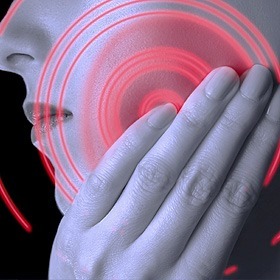The Temporomandibular Joint (hinge of the jaw) is a very unique joint with multiple complexities that are not seen in other joints. The movements required of the TMJ are multi-directional; The TM joints are the only joints in the human body that are interconnected to each other. The human jaw must be capable of vertical and lateral movement in order to be fully functional. The structures involved in the TMJ are also complex, consisting of multiple bones, muscles, cartilage and tendons.
TMJ disorders are compromised of a family of problems related to the structures involved. The symptoms may range for mild headaches to severe pain and inability to move your jaw joint. A thorough evaluation with Dr. Duraini would help delineate the structures involved in your particular case. The exact cause of your symptoms is not always clear. Prior history of trauma is one of the many potential causes that could lead to TMJ problems.

How do you know if you have a TMJ Disorder?
- Are you grinding or clenching your teeth?
- Do you wake up with stiff and sore muscles in your neck or around your jaw?
- Do you have neck aches or frequent headaches?
- Do you catch yourself clenching your teeth when stressed?
- Does clenching make your pain worse?
- Do you feel or hear popping, clicking, or grinding in your jaw joint when you open your mouth?
- Do you have pain or is it difficult to open your mouth to eat, or yawn?
- Do your have a history of trauma to the area?
- Do you have other joint problems? Or do you have a family history of joint problems?
- Have you noticed a change in your bite? Do your teeth not fit well anymore?
- Do you feel that your teeth meet in different places from time to time?
- Do you feel that your teeth are flat and worn? Are they sensitive or loose?
Answering ‘yes’ does not guarantee you have a TMJ disorder. However, the more times you answer ‘yes’ the more likely you do.
Diagnosis of TMJ Disorders and Treatment Options
Many treatment options are implemented to treat Temporomandibular Disorders. After your evaluation with Dr. Duraini you can discuss the treatment option that would be best for you. The evaluation will entail a focused history and physical, as well as obtaining the needed imaging if necessary.
At our office we have the ability to obtain 2-D images, as well as high-resolution Cone Beam CT (CBCT) scans (3-D scans) using the latest technology available. A CBCT will help Dr. Duraini visualize and diagnose certain disease processes in the TMJ. It also can be used to plan and fabricate a custom TMJ in case a Total Joint Replacement is needed. If further imaging is indicated Dr. Duraini will order an MRI from a local imaging center.
Once the information is collected and the type of disorder is identified, the proper course of treatment will be determined. Many treatment options are available ranging from non-surgical to surgical therapy.
The goals of non-surgical therapy are to reduce pain, decrease muscle spasm, and return the joint to normal function and range of movement. This can be achieved with pain relievers, muscle relaxants and anti-inflammatories. Splint therapy can be beneficial in certain cases. Home therapy and self-care is also effective and can range from jaw rest, soft foods, hot and cold therapy and jaw exercise.
Surgical therapy is an option for patients that do not respond well to non-surgical therapy and physical abnormalities are identified in the joint. Many procedures can be performed on the TMJ based on the findings. Dr. Duraini will discuss your surgical options in detail and discuss the risks and benefits of each procedure.
Many of these procedures are office based and minor while others may require Orthognathic (corrective jaw) Surgery. Orthognathic Surgery along with joint surgery is sometimes necessary if the joint degeneration has led to or worsened a facial deformity.



